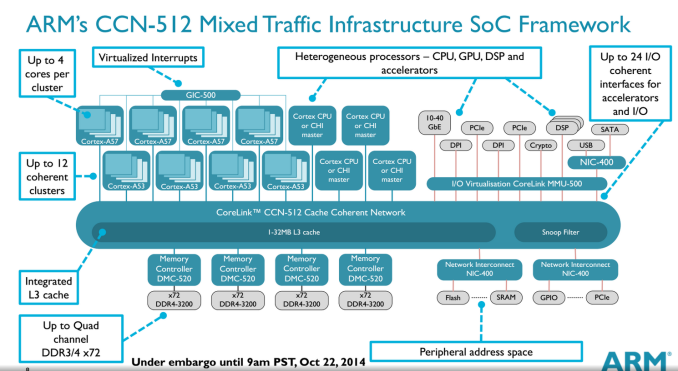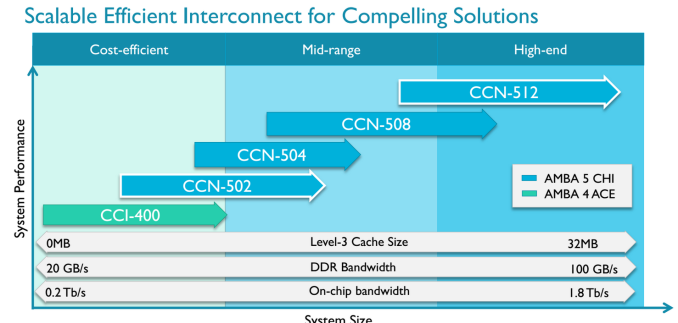ARM Challenging Intel in the Server Market: An Overview
by Johan De Gelas on December 16, 2014 10:00 AM ESTAMD Opteron A1100
The 28nm octal-core AMD Opteron A1100 is a lot more modest and aims at the low end Xeon E3s. Stephen has described the chip in more detail. To ensure a quick time to market, the AMD Opteron A1100 is made of existing building blocks already designed by ARM: the Cortex-A57 core and the Cache Coherent Network or CCN.
The AMD Opteron A1100 is one of the few vendors that uses the ARM interconnect. ARM put a lot of work into this design to enable ARM licensees to build SoCs with lots of accelerators and cores. CCN is thus a way of attaching all kinds of cores, processors, and co-processors ("accelerators") coherently to a fast crossbar, which also connects to four 64-bit memory controllers, integrated NICs, and L3 cache. CCN is very comparable to the ring bus found inside all Xeon processors beginning with "Sandy Bridge". The top model is the CCN-512 which supports up to 12 clusters of quad-cores. This could result in an SoC with 32 (8x4) A57 cores and four accelerators for example.
AMD would not tell us which CCN they are using but we suspect that it is CCN-504. The reason is this CCN was available around the time work started on the Opteron A1100 and the fact that AMD mentions the ARM bus architecture AMBA 5 in their slides. And it also makes sense: the CCN-504 supports up to 4 x 4 cores and supports the Cortex-A57.
It was rumored that the A1100 still used the CCI-400 interconnect, which is used by smartphone SoCs, but that interconnect uses the AMBA 4 architecture. Meanwhile the CCN-502 was announced in October 2014, way too late to be inside the A1100.
The AMD Opteron A1100 consists of four pairs of "standard" triple issue Cortex-A57 cores and 1MB L2 cache, with 8MB L3 cache.
The key differentiator is the cryptographic processor that can accelerate RSA (Secure Connection/hand shake) and AES (encrypting the data you send and receive) and SHA (part of the authentication). Intel uses the PCIe Quick Assist 89xx-SCC add-in card or the special Intel Communication chipset to provide a cryptographic coprocessor. These coprocessors are mostly used in professional firewalls/routers. As far as we know such cryptographic processors are of limited use in most https web services. Most modern x86 cores now support AES-NI, and these instructions are well supported. As a result, the current x86 CPUs from AMD and Intel outperform many co-processors when it comes to real world AES encoding/decoding of encrypted data streams.
A cryptographic coprocessor could still be useful for the RSA asymmetric encrypted handshake, but it remains to be seen if offloading the handshakes will really be faster than letting the CPU take care of it, as each offload operation causes all kinds of overhead (such as a system call). A cryptographic coprocessor running on the same coherent network as the main cores could be a lot more efficient than a PCIe device though. It has a lot of potential, but AMD could not give us much info on the current state of software support.














78 Comments
View All Comments
jjj - Tuesday, December 16, 2014 - link
If you look at phones and tabs ,we might be getting some rather big custom cores in 2015 and 2016. Apple and Nvidia already have that, ofc much smaller than Intel's core when adjusting for process (actually that's an assumption when it comes to Denver since don't think we've seen any die shots).Intel at the same time in consumer is pushing for more non-CPU/GPU compute units and low power and they might face a tough question about core size and even process (if they target low clocks, low power , or the opposite).Got to wonder if at some point they'll have to go for a big core just for server.Would make things even more interesting.
Might not matter but Apple kinda has the perf for an ARM Macbook Air if they go quad. Not something worth doing for such low volume but doable when they go quad on all ipads or sooner if they launch a bigger ipad. Could be a trigger for others pushing more ARM based Chromebooks and beyond. That would set the stage for even bigger ARM cores.
Also got the feeling Nintendo will go ARM in 2016 and not many reasons for Sony and M$ not to go that way if they ever make a new gen- just another market for bigger ARM cores, any significant revenue helps with dev costs so it matters.
CajunArson - Tuesday, December 16, 2014 - link
1. The Core-m is widely derided as not being fast enough for the MacBook Air.2. The Core-m is easily twice as fast as the A8X in benchmarks that count... even Anandtech's own benchmarks show that. Furthermore, when you step away from web browsers and get to use the advanced features of the Core-m like AVX, that advantage jumps to about 8x faster in compute-heavy benchmarks like Linpack.
3. Even the mythical A9 coming in 2015 is expected to have roughly a 20% performance boost over the A8x.
4. Any real computer using an ARM chip would have to have a translation layer just like the old Rosetta to run the huge library of x86 software out there. Rosetta sort of worked because the Core 2 chips from Intel were *massively* faster than the PowerPC parts they replaced. Now you expect to run the translation overhead on an A9 chip that is slower -- by a large margin -- than the Core-m parts you've already derided as not being good enough?
Yeah, I'm not holding my breath.
fjdulles - Tuesday, December 16, 2014 - link
You may be right, but remember that ARM chips using the same power budget as Intel core i* will no doubt be clocked higher and perform that much better. Not sure if that will be competitive but it would be interesting to see.wallysb01 - Tuesday, December 16, 2014 - link
Only if you want a glorified tablet as a laptop. The software most people use in real work on laptops/desktops is not going to be ported over to ARM at an speed, even if ARMs could do that work reasonably well.Kevin G - Wednesday, December 17, 2014 - link
I'm under the impression that a good chunk has already been ported. MS Office for example is native ARM on Windows RT. Various Linux distributions have ARM ports completed with ARM based office and desktop software. The main thing missing are some big commercial applications like Photoshop etc.The server side of thing is similar with Linux and open software ports. MS is weirdly absent but I suspect that an ARM based version of Windows 2012/2014 is waiting of major hardware to be released. Much of the Windows base is already ported over to ARM due to Windows RT.
Kevin G - Wednesday, December 17, 2014 - link
Indeed. Performance of ARM platforms once power constraints have been removed is a very open question. So far all the core designs in products have been used in mobile where SoC power consumption is less than 5 W. What a 100 W product would look is an open and very interesting question.Ratman6161 - Wednesday, December 17, 2014 - link
If they "use the same power budget as an Intel core i*" then what would be the point?jjj - Tuesday, December 16, 2014 - link
Ok you are focusing on the wrong thing but lets do that anyway.I have never claimed that Apple's own SoC would beat Intel's current SoCs, just that the perf would be enough if they go quad and obviously higher clocks.
When you talk Core M you should remember that the price at launch was $281 so it's not good enough for anything.
Anyway how about you compare a possible Apple SoC with a MacBook Air from 2011, lets face it the Air is a crap machine anyway , not much perf and TN panel for w/e ridiculous price it costs now and it's users are certainly not doing any heavy lifting with it.
At the same time Apple's own 15- 20$ SoC would allow them a much cheaper machine and a presence in a price segment they never competed in, adding at least 5B of revenue per year (including cannibalization) and a share gain in PC of 2-3%.
But then again the point was that there are a bunch of trends that could favor bigger ARM cores.
Morawka - Wednesday, December 17, 2014 - link
it might cost them $20 for the A8X in fab cost, but the R&D for that chip is in the 10's of millions. Factor that in, to however many they ship, and it adds at least another $20 per chipjospoortvliet - Wednesday, December 17, 2014 - link
Even more obvious then that this would save them money by spreading out the fixed costs over more devices...